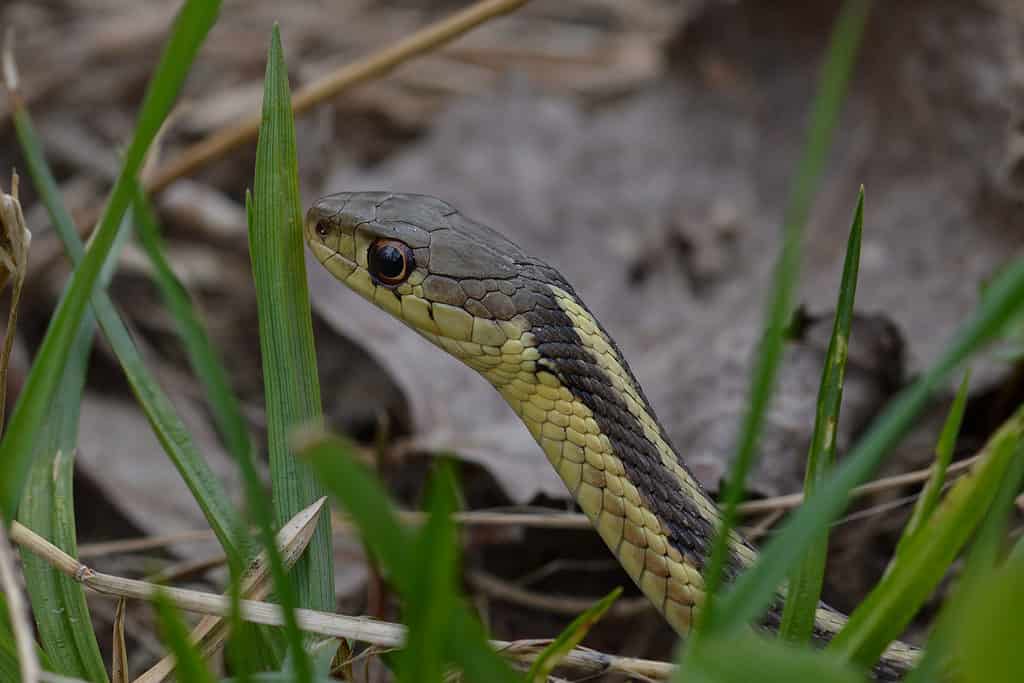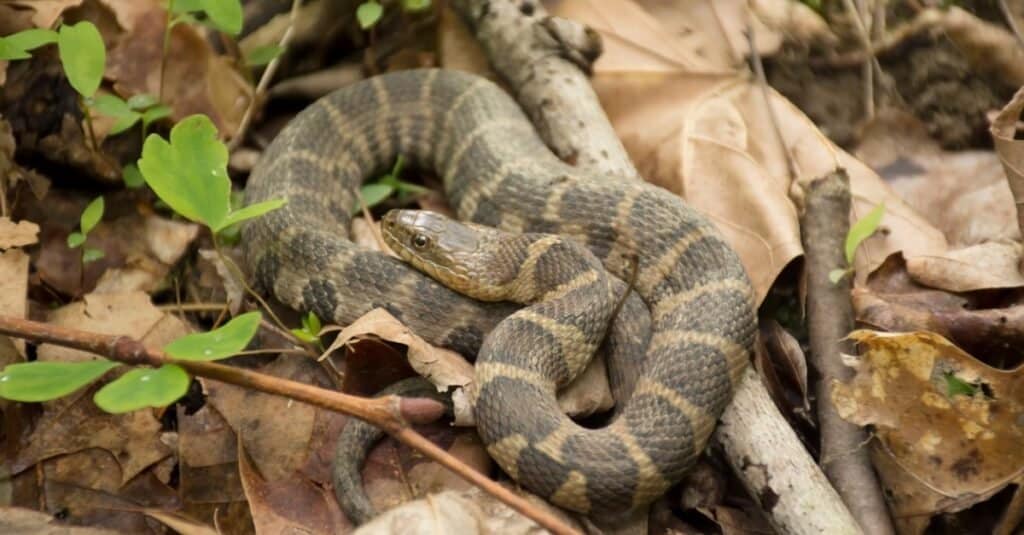There are all sorts of animals that live in Connecticut, but undoubtedly some of the most fascinating ones are snakes. There are 14 species in the state and they live in a wide variety of habitats. Although many of them live in forests and fields, there are also some which live in lakes, rivers, and even swamps. In fact, there are three water snakes in Connecticut. Read on to discover everything you need to know about them, including whether any of them are dangerous!
1. Eastern Garter Snake (Thamnophis sirtalis sirtalis)

Eastern garter snakes are one of the most common snakes in Connecticut.
©Ryan Hodnett, CC BY-SA 4.0, via Wikimedia Commons – License
The eastern garter snake is a subspecies of the common garter snake and is widespread across Connecticut. They are typically 18 to 26 inches long and have a dark brown to black body. They also have three stripes which are typically yellow. One stripe is located down the middle of their back, while the other two stripes are located on the sides of their bodies on the second and third rows of scales. They also often have alternating rows of black spots between their stripes.
Eastern garter snakes are common across the state and live in a variety of habitats, although they are usually located close to a permanent water source. They also prey on a wide range of animals both in and out of the water. However, fish and frogs make up a large portion of their diet. Eastern garter snakes usually hunt during the daytime, although they will sometimes hunt in the night during the frog and toad breeding seasons. Eastern garter snakes are not considered to be dangerous to humans, but they do use a substance that is similar to venom to incapacitate their prey. This is produced in the Durvenoy’s gland and is chewed into their prey rather than being injected.
Eastern garter snakes are active between March and early November. They are considered to be more cold-tolerant than many other species and are active longer than others and emerge from brumation earlier. They also often emerge from their dens during warm afternoons to drink and bask in the sun.
2. Eastern Ribbon Snake (Thamnophis sauritus sirtalis)

Although similar to the eastern garter snake, eastern ribbon snakes have a much thinner body.
©Steve Bower/Shutterstock.com
The next water snake in Connecticut is the eastern ribbon snake which is a species of special concern in the state. They are absent from Fairfield County but are found in most shallow wetland habitats throughout the rest of the state. However, habitat loss has led to a declining population in many places. Eastern ribbon snakes prey mainly on fish, frogs, toads, and salamanders. They typically grab their prey and swallow it alive.
Eastern ribbon snakes are approximately 20 to 32 inches long and have thinner bodies than eastern garter snakes. They are reddish-brown to black and have three yellow stripes. However, their lateral stripes are positioned on rows three and four. They also have a particularly long tail which is around one-third of their total length.
Eastern ribbon snakes are typically active between March and October, with the females giving birth in late July to early August. The litters usually consist of between 10 and 12 juveniles and once they are born the females leave them to fend for themselves. Eastern ribbon snakes reach sexual maturity at around three years old, and have a lifespan of up to 10 years.
3. Northern Water Snake (Nerodia sipedon)

Northern water snakes live in most freshwater habitats and prey mainly on fish.
©iStock.com/IcemanJ
The northern water snake is the only true water snake in Connecticut as it is a member of Nerodia. These snakes are widespread across the state, living in most freshwater habitats. They are powerful swimmers and can often be seen in the water with only their head visible. Northern water snakes can also completely submerge themselves when needed to search for food at the bottom of the water. They prey mainly on fish, although they also eat frogs, toads, crayfish, and salamanders. They have sharp, backwards-pointing teeth so that they can quickly grab and hold their prey. Northern water snakes can be highly defensive if they are threatened and may bite. Although they are not venomous, they do have an anti-coagulant in their saliva which causes any wounds that they inflict to bleed more than usual.
Northern water snakes are large snakes, ranging between 24 and 42 inches long. They typically have tan to reddish-brown bodies with darker crossband markings which become blotches as they near their tail. Northern water snakes have a similar appearance to the venomous cottonmouth, although the cottonmouth does not occur in Connecticut.
Northern water snakes are active between April and early October, with mating taking place in April and May. They juveniles are typically born from August to October, with 20 being the average litter size. Northern water snakes overwinter in dens, usually in small groups.
The photo featured at the top of this post is © iStock.com/Wildnerdpix
Discover the "Monster" Snake 5X Bigger than an Anaconda
Every day A-Z Animals sends out some of the most incredible facts in the world from our free newsletter. Want to discover the 10 most beautiful snakes in the world, a "snake island" where you're never more than 3 feet from danger, or a "monster" snake 5X larger than an anaconda? Then sign up right now and you'll start receiving our daily newsletter absolutely free.
Thank you for reading! Have some feedback for us? Contact the AZ Animals editorial team.






